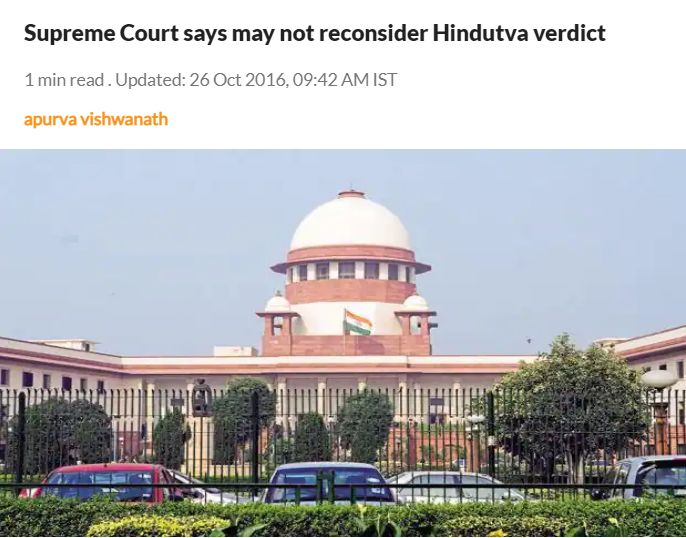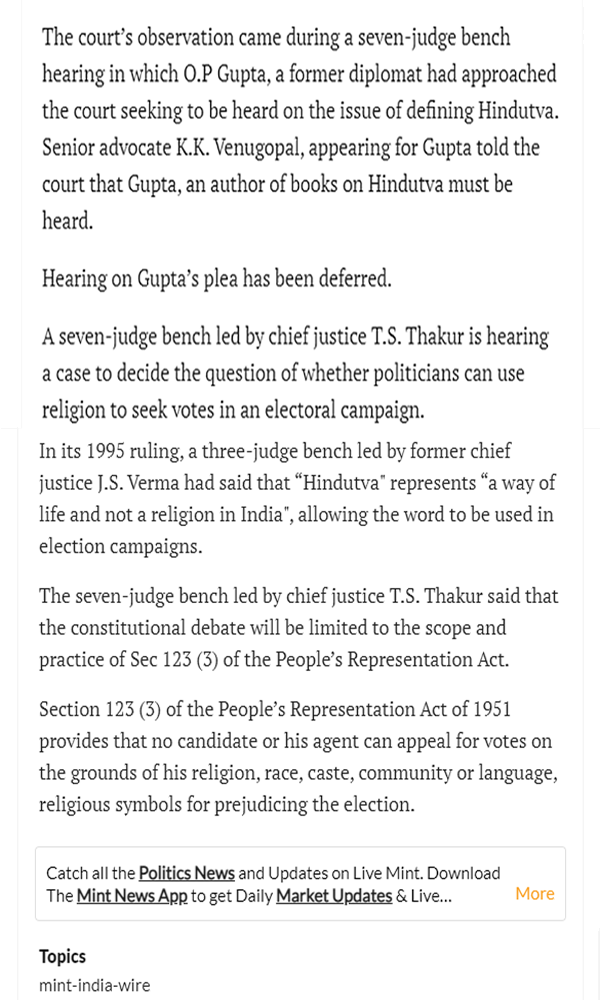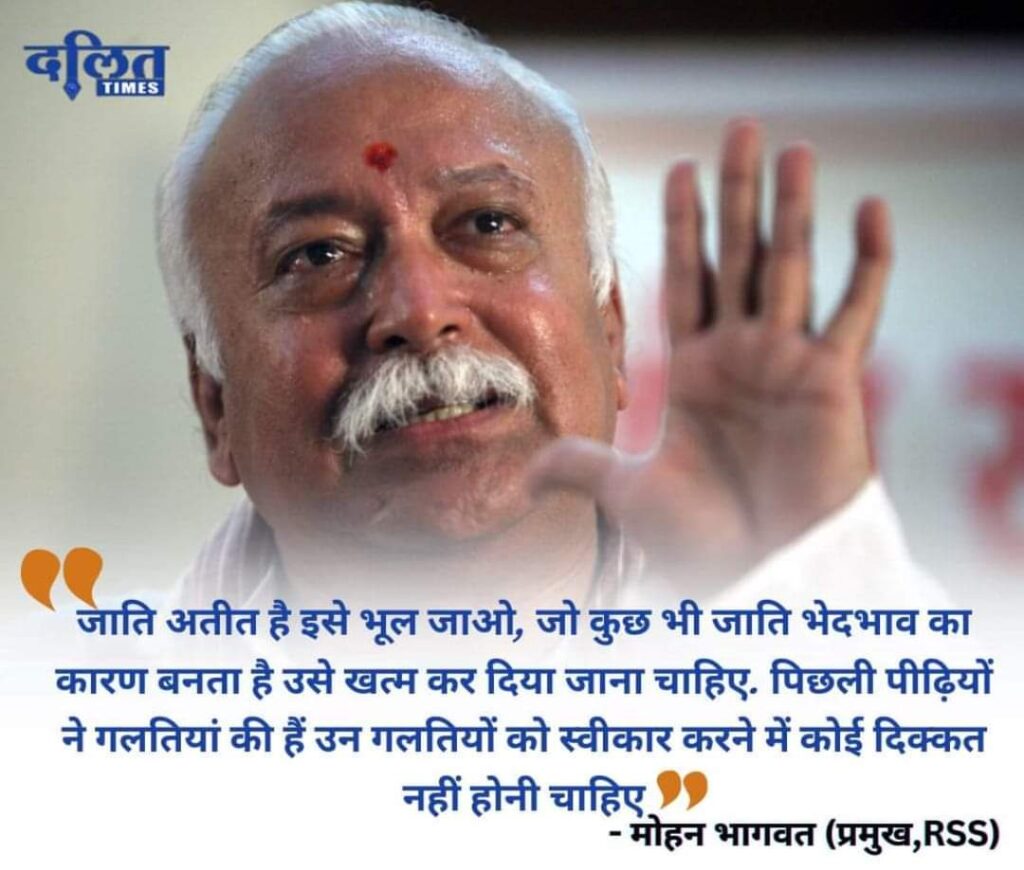Ambassador OP Gupta National President SAMARASATA FOUNDATION
Hindutva has been made a hot political potato on national as well as on international platforms by people with vested interests. One recalls the Dismantling Global Hindutva Conference held in 2021to look into issues related to Hindutva which organizers presented as Hindu Supremacist ideology. This virtual conference was claimed to have been sponsored by over 50 US Universities including Stanford, Harvard, Princeton, New York University etc. Nearer the home, Salman Khurshid a former Cabinet Minister in many Congress Governments in his recent book called Hindutva a political philosophy similar to jihadist Islam of groups like ISIS and Boko Haraam of recent years. Some allege that Hindutva is anti-minority, some allege that it spreads hate against non-Hindus, some compare it to jihadi forces like ISIS and boko haraam, some allege that it is a fascist ideology, some allege that it aims at restoring supremacy of Brahmins over non-Brahmins etc. Such wild criticism of Hindutva shows total ignorance of its critics as to what Hindutva actually stands for.
Hindutva stands for gender equality among Hindus and social equality of all Hindus. No one should have any objection to these twin principles of Hindutva which are based on Rig Veda commandments of gender equality (ardhyanarishwar) and that all followers of Vedas are equal by birth, no one is superior by birth, no one is inferior by birth, and, all followers are brothers and sisters sharing same gods, same prayers, same water wells, same temples, that all Hindus should live in harmony and unity etc. Hindutva, thus, does not support concept of birth based castes. There is no upper caste lower caste syndrome in Hindutva fold. Hindutva principles are also in conformity with Articles 14, 15 and 17 of the Constitution of India deepening and widening socio-religious acceptability of these constitutional articles even among the orthodox Hindus.
Ek Hindu ki dusare Hindu ke prati bhaichaare ki bhawana ko Hindutva kahate hai. Hum sab Hindu ek hai ki bhawana ko Hindutva kahate hai. Espirit de corps among Hindus irrespective of caste, colour, language, religious sects, place of birth, country of residence & profession and one’s political ideology is called Hindutva. Hindutva calls for cultural unity and social harmony among all Hindus.
Hindutva is a global concept as Hindus are there in almost all countries of the world. Shri Mohan Bhagwat, RSS Chief rightly said: a Hindu is a Hindu till he feels pains of other Hindus living in any part of the world. (Organizer September 6, 2009).
The word Hindutva is misrepresented by ill informed people and anti-Hindu politicians to imply that Hindutva is hostile to religious minorities which is not true as basic principles of Hindutva are based on the holy Vedas which were revealed much before births of Christianity and Islam. Therefore there can be no anti-minority content in Hindutva . It is anchored on Hindu ethos of Vasudhaiva kutumbak, ekam sad vipra bahudha vadayanti (RV1.164.46) and sarve bhavantu sukhinah sarve santu niramayah so it is not hostile suo motu to non-Hindus; it assures equal treatment to those who follow other religions. Hindutva upholds multicultarism.
Veer Savarkar (Vinayak Damodar Savarkar, 1883-1966) restated the Hindutva principles in language of the day in his 1923 book Essentials of Hindutva so as to make these understood by common masses of Hindus who did not know Sanskrit, ek deva, ek desh, ek jaaat, ek jana and ek jeev. Veer Savarkar’s definition re-ignited feelings of pan India unity among Hindus, re-ignited Hindu rastravad among Hindus and aimed at eradication of birth based casteism and caste based discriminations among Hindus. The dark forces which want Hindus to remain weak and submissive and divided vertically and horizontally into castes and sub-castes keep demonising Hindutva.
Dr BR Ambedkar wanted annihilation of castes primarily through legal and political means but did not succeed. Savarkar tried to annihilate casteism by emphasizing social and cultural unity among Hindus, ek jaat, ek jana. Gandhi ji by his efforts succeeded in diluting caste barriers. In my view emancipation of SC ST Hindus from grip of casteism shall take place as and when unifying principles of Hindutva sink deeper and deeper in minds of Hindu masses.
It should be kept in mind that Vedas, Gita and Manusmriti divide people profession-wise into four classes, four Varnas (chaaturvarnyam). Varna meant profession, occupation. There is no sanction for birth based varnas in Vedas, Gita and Manusmriti. Foreigners incorrectly translated Varnas into castes which later became rigid birth based castes. Varna of a person was decided by the Acharya of a Gurukul which he attended as the Vice Chancellor of any present day University decides whether a student will be a medical doctor or an engineer. As a person changed his profession, his Varna automatically changed. Manusmriti specifically sanctions social migration from one varna to another varna by one’s own efforts, therefore, even Manusmriti does not sanction birth based varnas.
Dr BR Ambedkar emphasized that the caste system was a social division of people of the same race. Ambedkar emphasized: “Birth based Caste is the bane of the Hindus. Caste is the cause of the down fall of the Hindus. Owing to caste the Hindu’s life has been a life of continuous defeats. Caste has made the Hindus the sick men of India.” (Dr BR Ambedkar Life and Mission page 269 and 270 by D.Keer). Ambedkar worked hard for annihilation of castes but did not succeed. Hindutva principles also aim to achieve goal set by Ambedkar to annihilate castes but by relying upon Vedic richas to change mindset of the Hindu samaj.
Hon’ble Supreme Court of India rightly ruled that office of Hindu temple priests cannot be hereditary ( JJ K Ramaswamy & BL Hansaria March 1996). In October 2002 JJ Rajendrababu & Doraiswamy Raju held that non-brahimans are also eligible to perform religious ceremonies and work as temple priests if they are well versed with relevant rituals, These decisions are consistent with Hindutva principles as well as with RV(10.125.5), RV(10.98.7) and Manusmriti (10.65) etc. Female priests are also sanctioned in Vedas RV (5.28).
Rigveda calls for unity among its followers so also does Hindutva . Principles of Hindutva are reflected in the following richas:
सं ग॑च्छध्वं॒ सं व॑दध्वं॒ सं वो॒ मनां॑सि जानताम् । दे॒वा भा॒गं यथा॒ पूर्वे॑ संजाना॒ना उ॒पास॑ते ॥
saṃ ghachadhvaṃ saṃ vadadhvaṃ saṃ vo manāṃsi jānatām |
devā bhāghaṃ yathā pūrve saṃjānānā upāsate || HH Wilson translates: “Meet together, talk together, let your minds apprehend alike: in like manner as the ancient gods concurring accepted their portion of the sacrifice.” RV (X.191.2)
स॒मा॒नो मन्त्र॒: समि॑तिः समा॒नी स॑मा॒नं मन॑: स॒ह चि॒त्तमे॑षाम् । स॒मा॒नं मन्त्र॑म॒भि म॑न्त्रये वः समा॒नेन॑ वो ह॒विषा॑ जुहोमि ॥
samāno mantraḥ samitiḥ samānī samānaṃ manaḥ saha cittameṣām |
nsamānaṃ mantramabhi maṇtraye vaḥ samānena vohaviṣā juhomi || “Common be the prayer of these (assembled worshippers), common be the acquirement, common the purpose, associated be the desire. I repeat for you a common prayer; I offer for you a common oblation.” RV (X.191.3)
स॒मा॒नी व॒ आकू॑तिः समा॒ना हृद॑यानि वः । स॒मा॒नम॑स्तु वो॒ मनो॒ यथा॑ व॒: सुस॒हास॑ति ॥
]Samānīvaākūtiḥsamānāhṛdayānivaḥ|
samānamastu vomano yathā vaḥ susahāsati ||“Common (worshippers), be your intention; common be (the wishes of) your heart; common be your thoughts, so that there may be thorough union among you.” RV (X.191.4)
अ॒ज्ये॒ष्ठासो॒ अक॑निष्ठास ए॒ते सं भ्रात॑रो वावृधु॒: सौभ॑गाय । युवा॑ पि॒ता स्वपा॑ रु॒द्र ए॑षां सु॒दुघा॒ पृश्नि॑: सु॒दिना॑ म॒रुद्भ्य॑: ॥ RV (5.60.5) ajyeṣṭhāso akaniṣṭhāsa ete sam bhrātaro vāvṛdhuḥ saubhagāya | yuvā pitā svapā rudra eṣāṃ sudughā pṛśniḥ sudinā marudbhyaḥ || “No one is superior or inferior. All are brothers. All should strive for the interests of all and should progress collectively.”
Atharvaveda (III.30.6): “Your drinking saloon be the same, in common your share of food, in the same harness do I join you together; worship you Agni united, like spokes about a navel.”
Atharvaveda (III.60.7) commands: “United, like minded I make you of one bunch, all of you, by my conciliation; (be) like the gods defending amrita; late and early be well willing yours”.
Purus Sukta
यत्पुरु॑षं॒ व्यद॑धुः कति॒धा व्य॑कल्पयन् । मुखं॒ किम॑स्य॒ कौ बा॒हू का ऊ॒रू पादा॑ उच्येते ॥ RV(10.90.11)
yat puruṣaṃ vy adadhuḥ katidhā vy akalpayan | mukhaṃ kim asya kau bāhū kā ūrū pādā ucyete || “When they immolated Puruṣa, into how many portions did they divide him? What was his mouth called, what his arms, what his thighs, what were his feet called?”
ब्रा॒ह्म॒णो॑ऽस्य॒ मुख॑मासीद्बा॒हू रा॑ज॒न्य॑: कृ॒तः । ऊ॒रू तद॑स्य॒ यद्वैश्य॑: प॒द्भ्यां शू॒द्रो अ॑जायत ॥RV(10.90.12)
brāhmaṇo ‘sya mukham āsīd bāhū rājanyaḥ kṛtaḥ | ūrū tad asya yad vaiśyaḥ padbhyāṃ śūdro ajāyata |“His mouth became the Brāhmaṇa, his arms became the Rājanya, his thighs became the Vaiśya;the Śūdra was born from his feet.”
The above two richas of the purus sukta of Rig Veda (X.90.11 & 12) are often mis-quoted to claim Vedic sanction for birth based castes, upper caste-lower caste syndrome and untouchability. On the contrary these two richas state that as in a healthy person his mouth, arms, body and legs work in perfect harmony with each other similarly that society shall be strong in which brahimins (intellectuals) (mouth), rajnya (administration, soldiers, government) (arms), vaishya (agriculture, animal husbandry and trade) (body, torso) and shudra (working class, unskilled, uneducated) (feet) are in perfect harmony. If the four limbs of human body are disjointed even the Virat Purusa gets killed, immolated. Thus Purus sukta commands unity and harmony among all four classes of its followers to have a strong society.
In Gita (IV.13) Lord Krishna says: “Chaturvarnyma mayaa sristam gunkarma vibhagsah” i.e. four classes of society created by Me according to their Guna (aptitude ,qualities, behavior ,temperament) and Karma (performance, education, training, actions done, skills acquired, professional competence, efforts put into by the individual). One may note that Lord Krishna does not say guna and karma of the previous life.
In shloka (XVIII.41), Lord Krishna says “Brahmana Kshatriya visham shudranam cha paramtapa, karmani pravibhaktani svabhavaprabhavaigunaih.” It means people have been grouped into four classes according to their present life karma (skills, education, and acquired competence) and svbhavaa (aptitude, behaviour, person’s nature, temperament). In modern terminology it is division of labour based on qualifications and skills acquired. Had this division been based on birth, Lord Krishna would have naturally used the phrase “Janmani pravibhaktani” in shloka (XVIII.41) which He has not done. Svabhava/behavior naturally relates to, and, can relate only to the present life.
In ancient India education was given in gurukuls. At the time of leaving gurukul after completion of studies the Acharya of gurukul determined varna of students, those who were the best in Vedas and scriptures (preaching and teaching) were placed in Brahman varna, those who were good in martial arts were placed in rajnya varna, those who were good in commerce, farming and animal husbandry were put in vaishya varna and all remaining in Sudra varna. It is like present day Universities and education boards placing students into four classes i.e. First division, second division, third division and failed division. A failed student is allowed to move up by putting more efforts.
Manusmriti (X.65) sanctions migration from one Varna to other varna i.e. varna is not birth based. It reads:
शूद्रो ब्राह्मणतामेति ब्राह्मणश्चैति शूद्रताम् । क्षत्रियाज् जातमेवं तु विद्याद् वैश्यात् तथैव च ॥ ६५ ॥
śūdro brāhmaṇatāmeti brāhmaṇaścaiti śūdratām |
kṣatriyāj jātamevaṃ tu vidyād vaiśyāt tathaiva ca || 65 || manusmriti (10.65)
The Śūdra attains the position of the Brāhmaṇa and the Brāhmaṇa sinks to the position of the Śūdra; the same should be understood to be the case with the offspring of the Kṣatriya or of the vaiśya.
यथा काष्ठमयो हस्ती यथा चर्ममयो मृगः । यश्च विप्रोऽनधीयानस्त्रयस्ते नाम बिभ्रति ॥ १५७ ॥
yathā kāṣṭhamayo hastī yathā carmamayo mṛgaḥ |
yaśca vipro’nadhīyānastrayaste nāma bibhrati || MS (2.157)
As the elephant made of wood, as the deer made of leather, so the non-learning Brāhmaṇa,—these three merely bear their names.
यथा षण्ढोऽफलः स्त्रीषु यथा गौर्गवि चाफला । यथा चाज्ञेऽफलं दानं तथा विप्रोऽनृचोऽफलः ॥ १५८ ॥
yathā ṣaṇḍho’phalaḥ strīṣu yathā gaurgavi cāphalā |
yathā cājñe’phalaṃ dānaṃ tathā vipro’nṛco’phalaḥ || MS (2.158)
As the eunuch is useless among women, as the cow is useless among cows, as a gift to the ignorant person is useless, even so is the Bbrāhmaṇa useless who is devoid of the Veda.
Above shlokas of Manusmriti reaffirm that varna is not birth based but qualification based. However there are some shlokas in present day available Manussmriti which are contradictory to other Manusmriti shlokas and are also violative of Vedas suggesting later additions and interpolations which should be expunged from Manusmriti through a dharma sansad. Manusmriti itself provides for such an action under shloka 12.111 and 12.112 etc.
There are some differences between what is perceived to be traditional Hinduism and Hindutva. MK Gandhi ji felt that varna and caste were birth based which Hindutva does not accept. In Hindutva these are not birth based but one’s own qualification based. Gandhi’s traditional Hinduism is portrayed by his supporters as tolerant ad infinitum and submissive, the Hindutva consistent with Vedic preaching commands swift and substantive retaliation to aggressors. Even Gandhi ji disapproved cowardice of Hindus. Gandhiji repeatedly clarified that his non-violence was not for cowards as only strong could forgive. In wake of Saharanpur Hindu-Muslim riots of 1923, Gandhiji said:“ rather than getting angry with Muslims for their violence, I, being a Hindu, feel ashamed of cowardice of Hindus……between violence and cowardly submission/escape I would rather prefer violence”. In Young India of May 29, 1924 Gandhiji wrote: “Should Hindus hold Muslims responsible for their own cowardice? Oppressors go where so ever there are cowards”. Message of Gandhiji was loud and clear to Hindus to prepare for self defence which is what the Hindutva preaches.
Right of self defence against aggressors is guaranteed under sections 96 to 107 of the Indian penal Code as well as under international laws. Various Supreme Court of India case laws such as 2022 LiveLaw (SC) 551 of June 2022 etc give legal authority to all Indians including Hindus to take steps to defend their lives and properties against aggressors till the state machinery arrived at the spot.
Hindutva, thus, stands for restoring cultural unity & social harmony among all sections of Hindus. It is neither anti-minority nor a political philosophy. Those who do not harbor any harm to Hindus should not be apprehensive of Hindutva which aims to reform Hindu samaj from within by discarding age old excess baggage of upper caste lower caste syndrome and restoring gender equality.
***********************************************************************
Following is a report which appeared in Livemint



